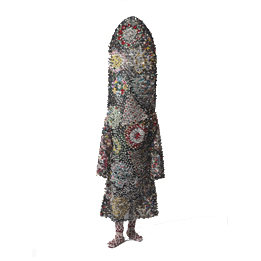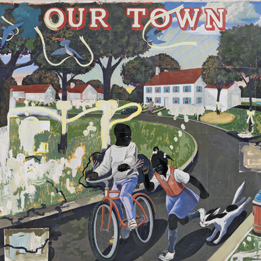Big Idea
DOES CONTEMPORARY AMERICAN ART EXPLORE IDENTITY?
Have you ever looked at a piece of modern art in a museum and thought to yourself, “I don’t get it! Why is that art?”
The purpose and meaning of art has changed over time, including a period in the recent past that demanded art for art’s sake—that art should not teach or moralize, but should only be beautiful. This gave permission for abstract expressionism to develop—shapes and forms that seem to be divorced from all context, such as in this painting by Arthur Beecher Carles.
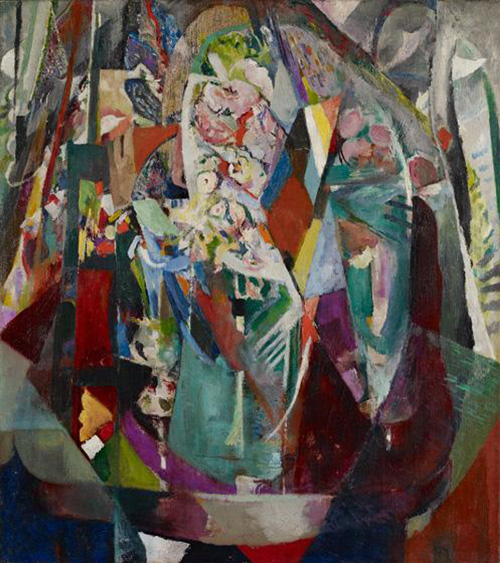
The other side of the coin is art that is meant to instruct, such as this family portrait that shows us an affluent and prestigious family from the 1830s. In this painting, every object is full of meaning, such as the thimble and thread, which are symbolic of the girl’s talent for sewing. What message do you get from the fine furnishings, the gold watches, and the fancy clothing?
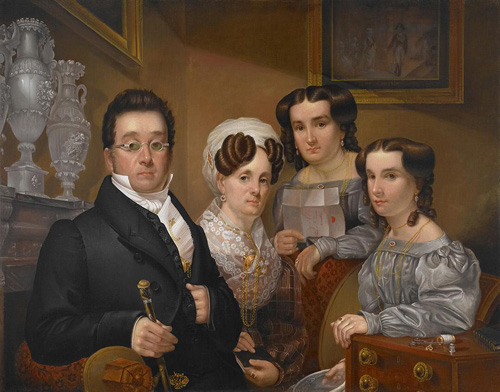
Fast forward to now, when art may tend toward abstraction or include representational narratives—many styles and artistic intents co-exist at once. In this course, we do consider the aesthetic properties of art, but the emphasis will be on the underlying context and what it says about American identity. Both artworks we look at in Session 1, Soundsuit by Nick Cave and Our Town by Kerry James Marshall, were carefully crafted by the artists to convey specific thoughts about the placement of their communities within American society—which you will learn much more about!
In Session 1, you learn how to describe the appearance of the two selected artworks in the Gallery, a process that is called formal analysis. We also make interpretations about the subject matter, and look for connections between the historical context of the art and more contemporary contexts of today. By the end of the session, you should have a better idea of what Soundsuit and Our Town reveal about American identity.
In this session you will explore how...
- to use formal analysis to better see art
- artworks can act as primary sources that help us to understand history
- a museum curator works to tell stories to an audience of viewers
- you can express thoughts about yourself and your community with snapshots
Overview
In Part 1, you learn how to analyze the formal properties of an artwork from an art historical perspective, make a Word Cloud of art vocabulary, and listen to other students describe an artwork in the Crystal Bridges collection.
Read
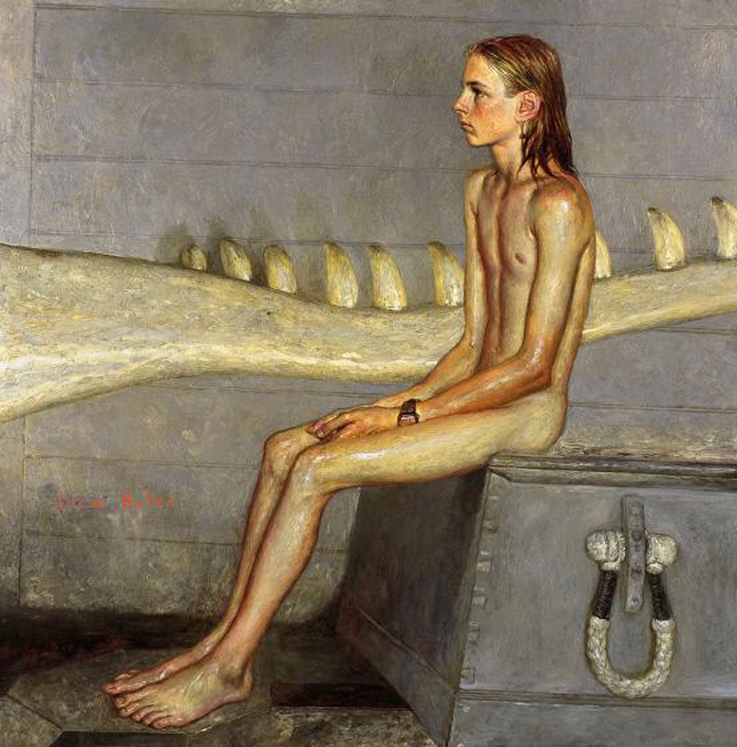
Looking at art from an art history perspective is different from looking at art as a casual museum visitor.
When you’re looking at art for art’s sake, you simply decide whether or not you like it, but looking at a work from an art history perspective requires that you dig deeper.
Art historians look at artworks as more than beautiful (or not beautiful!) objects. To analyze a work of art and determine what it is that makes each piece significant or meaningful they consider its formal properties, subject matter, and historical context.
- Download the file, Orca Bates Assignment. (Note: This assignment will automatically download to your computer when the link is clicked. You will need to go to your downloads file on your computer to open the file. Save this file to your computer as you add your thoughts.)
- Look at the painting above, titled Orca Bates. What do you see? Write your answer in Part 1 of the Orca Bates Assignment file.
- Read “Jamie Wyeth's ‘Orca Bates’: Picturing Maine” by Christopher Crosman, a former curator at Crystal Bridges Museum, which was published in The Free Press. It is a good example of an art historical analysis.
- Complete Part 2 of the Orca Bates Assignment.
- Upload your completed assignment to Reflection Journal: Session 1, Orca Bates Assignment.
Read

Looking at art from an art history perspective is different from looking at art as a casual museum visitor.
When you’re looking at art for art’s sake, you simply decide whether or not you like it, but looking at a work from an art history perspective requires that you dig deeper.
Art historians look at artworks as more than beautiful (or not beautiful!) objects. To analyze a work of art and determine what it is that makes each piece significant or meaningful they consider its formal properties, subject matter, and historical context.
- Download the file, Orca Bates Assignment. (Note: This assignment will automatically download to your computer when the link is clicked. You will need to go to your downloads file on your computer to open the file. Save this file to your computer as you add your thoughts.)
- Look at the painting above, titled Orca Bates. What do you see? Write your answer in Part 1 of the Orca Bates Assignment file.
- Read “Jamie Wyeth's ‘Orca Bates’: Picturing Maine” by Christopher Crosman, a former curator at Crystal Bridges Museum, which was published in The Free Press. It is a good example of an art historical analysis.
- Complete Part 2 of the Orca Bates Assignment.
- Be prepared to submit the assignment to your teacher.
Watch
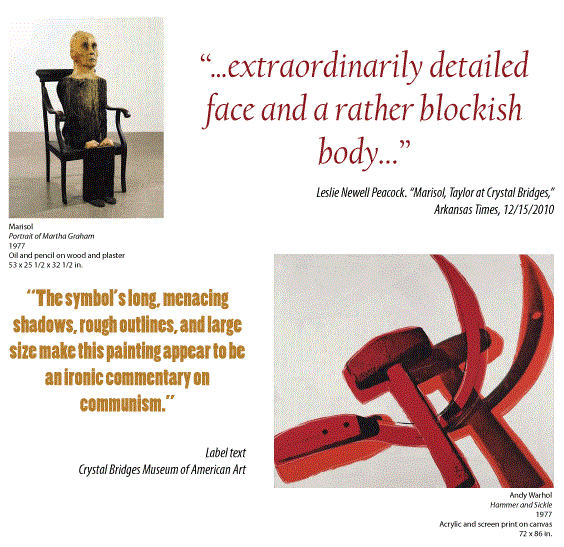
Art critics and art historians have developed their own language for describing the formal properties of artworks. Formal properties are the physical attributes of the artwork—how its paint is applied, or how its features are carved. Formal properties also describe the style of the artwork—whether the brush strokes are visible or refined; whether the colors are bright or subdued, and whether the composition is dynamic or static. Formal properties describe composition: the arrangements of the parts in the work. An artist may put the most important part of the painting in the center so that you see it immediately, or the artist may use other methods to draw your eye to a specific figure. The artist may use a shaft of sunlight to create drama, or use oddly sized objects to highlight their importance.
Here are two videos that describe formal analysis (also called visual analysis).
Introducing Formal Analysis: Still Life, from the J. Paul Getty Museum, gives a quick explanation of formal analysis.The Smarthistory video How to Do Visual (Formal) Analysis in Art History goes into more detail about the elements that compose an artwork.
DISCUSSION
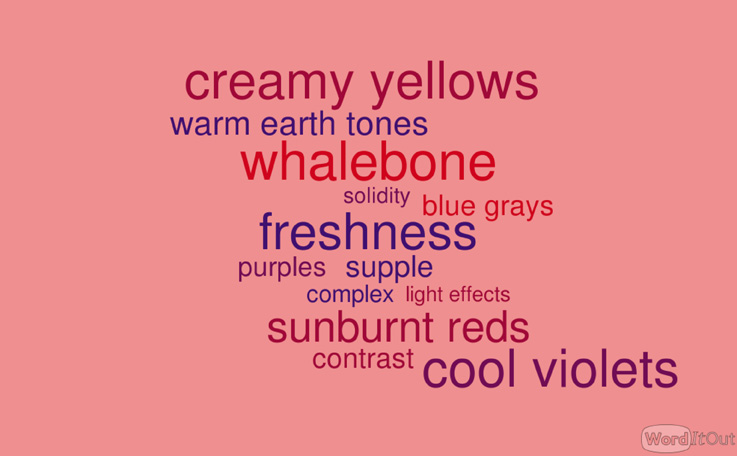
- Make a Word Cloud that includes an assortment of the vocabulary words that are used to describe art in a formal analysis. Save it and share your masterpiece in Discussion Forum: Session 1, Formal Analysis Word Cloud. You may use this as a writing guide for the rest of the course, so be thorough!
- Look at your completed Orca Bates Assignment and highlight each example of formal analysis that you find. Go back to Crosman’s review of Orca Bates to flesh out your answers as needed.
Classroom Discussion

- Make a Word Cloud that includes an assortment of the vocabulary words that are used to describe art in a formal analysis. Save it and be prepared to share you masterpiece with your class. You may use this as a writing guide for the rest of the course, so be thorough!
- Look at your completed Orca Bates Assignment and highlight each example of formal analysis that you find. Go back to Crosman’s review of Orca Bates to flesh out your answers as needed.
Watch
Let’s see how a group of students observe and talk about a sculptural piece at Crystal Bridges: Soundsuit by Nick Cave. Do they notice the same things you do about this piece? What else did you notice? Is there anything that you could add, using vocabulary from the previous two videos on formal analysis?
TranscriptReflection Journal
And finally: It’s your turn!
Write a formal analysis of Soundsuit in Reflection Journal: Session 1, Soundsuit Formal Analysis. Your analysis should begin with an introduction of the artwork, including the artist’s name, title of the work, and year it was made. Then describe its physical properties: colors, shapes, and other relevant characteristics.
Reflection Journal
And finally: It’s your turn!
Write a formal analysis of Soundsuit in your reflection journal. Your analysis should begin with an introduction of the artwork, including the artist’s name, title of the work, and year it was made. Then describe its physical properties: colors, shapes, and other relevant characteristics.
Overview
In Part 2, you expand your understanding of Soundsuit by learning about the artist, Nick Cave, and the context in which he created this work.
WATCH
Watch Nick Cave Brings Art, Sculpture to Life With Soundsuits from PBS NewsHour. Consider how Cave’s work is meant to convey ideas about identity. Is he making a statement about his personal identity? Is he expressing sentiments about his community’s identity? What, exactly, is he trying to say through his artwork?
Read
Read "About the Art: Soundsuit".
Remember what you heard from Nick Cave in the video:
And then I started thinking about the role of identity, being a racial profile, feeling devalued, less than, dismissed. And then I happened to be in the park this one particular day and looked down on the ground, and there was a twig. And I just thought about, well, that's discarded, and it's sort of insignificant. And so I just started then gathering the twigs, and before I knew it, I had built a sculpture.
Since that time, Nick Cave has continued to make art that challenges discrimination and racism. Read about his latest art installation, which is scheduled for exhibition at Crystal Bridges in 2018, in the article “Rethinking the Town Hall: Nick Cave on ‘Until,’ His Massive MASS MoCA Installation” from ARTNEWS.
If you are interested in more details about Rodney King, or the longstanding problems that have affected poor and minority communities in the United States, go to Part 5: Deep Dive.
REFLECTION JOURNAL
How do Nick Cave’s thoughts of the twigs as “discarded” and “insignificant” connect to what was happening in Los Angeles with Rodney King and the LAPD officers? What is he trying to say about his community and the people who live there?
How does his new installation, Until, extend or expand on his earlier work? How does it connect contemporary events to events of the 1990s?
Write an entry in your Reflection Journal: Session 1, Nick Cave that explains your understanding of these connections. Use evidence from the articles and video, with in-line citations to credit your sources.
REFLECTION JOURNAL
How do Nick Cave’s thoughts of the twigs as “discarded” and “insignificant” connect to what was happening in Los Angeles with Rodney King and the LAPD officers? What is he trying to say about his community and the people who live there?
How does his new installation, Until, extend or expand on his earlier work? How does it connect contemporary events to events of the 1990s?
Write an entry titled "Session 1: Nick Cave" in your reflection journal that explains your understanding of these connections. Use evidence from the articles and video, with in-line citations to credit your sources.
Overview
In Part 3, you expand your understanding of Our Town by learning about the artist, Kerry James Marshall, and the context of his work. You then consider both Kerry James Marshall and Nick Cave’s work in a broader context, as well as the work of another Watts artist, Sabato Rodia (1879–1965). You combine this contextual information with your new skills at formal analysis to write about the art of this session.
EXPLORE
Explore the two resources below about Kerry James Marshall.
- "Kerry James Marshall: Depicting the world as he sees it," CBS Sunday Morning
- "The art of Kerry James Marshall," CBS Sunday Morning
After exploring the resources, look carefully at Our Town, located in the Gallery.
Consider how Marshall’s work is meant to convey ideas about identity. How does he want viewers to interpret the extreme blackness of his figures? What sentiment is he expressing about the role of black communities in America? What does it seem he is trying to say through his artwork?
Read
Explore what happened in Birmingham in 1963 and in Watts in 1965 in these photo essays:
- "Unseen photographs of civil rights conflict in Birmingham, Alabama, 1963." The Guardian (May 12, 2018)
- “Watts riots eerily echo racial tensions 50 years later” by Olivia Kestin and Adam Howard, MSNBC (August 11, 2015)
Kerry James Marshall has said of his work:
You can’t be born in Birmingham, Alabama, in 1955 and grow up in South Central [Los Angeles] near the Black Panthers headquarters, and not feel like you've got some kind of social responsibility. You can’t move to Watts in 1963 and not speak about it. That determined a lot of where my work was going to go.
More details can be found in these featured readings.
- "About the Art: Our Town"
- “Kerry James Marshall’s Paintings Show What It Means to Be Black in America” by Holland Cotter, a New York Times article reflecting on Marshall’s 35-year career in art.
- If you are interested in more details about the history of the civil rights movement, or what was happening in the Watts neighborhood of Los Angeles in the 1960s, go to Part 5: Deep Dive.
Reflection Journal
Now that you have looked closely at this session’s artworks and learned about the meaning of these pieces, it’s time to write a description of Our Town that includes both formal analysis and context. Go to Reflection Journal: Session 1, Art History Analysis. Your writing should include:
- Artist’s name, title of work, and date
- Formal analysis that includes at least three components of the work (color, shape, line, etc.)
- Brief description of the artwork that includes what it is and why it was made
- Contextual connections to other artworks from this session
Reflection Journal
Now that you have looked closely at this session’s artworks and learned about the meaning of these pieces, it’s time to write a description of Our Town that includes both formal analysis and context. Write an entry titled "Session 1: Art History Analysis" in your reflection journal. Your writing should include:
- Artist’s name, title of work, and date
- Formal analysis that includes at least three components of the work (color, shape, line, etc.)
- Brief description of the artwork that includes what it is and why it was made
- Contextual connections to other artworks from this session
Explore
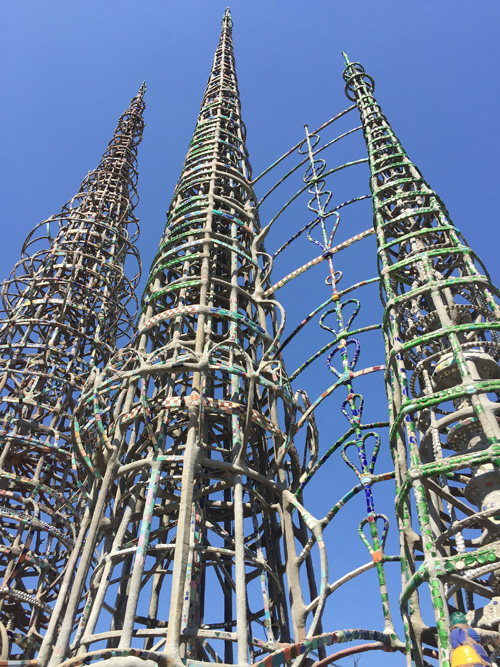
Nick Cave and Kerry James Marshall, through their artworks, offer us insight into the frustrations felt by the Watts community in Los Angeles—longstanding issues that led to the riots of 1992. Unfortunately, the riots did not solve the community’s problems. We can see from the activism surrounding Black Lives Matter (which was founded in 2013) that many people believe that systemic racism is still present in America.
Sabato Rodia, an Italian immigrant who began his work in 1921, made monumental artworks that expressed his passion and love for the Watts community. While his works were originally his own personal expressions, they have been adopted by the neighborhood and have inspired community pride for generations of Watts residents. Read about the very quirky Watts Towers, also called Nuestro Pueblo (Our Town) in the article “Towers of Power” by Sara Catania which appeared in the Los Angeles Times.
Consider how reading about the problems in Watts that preceded its existence as a Black neighborhood might further expand your understanding of the issues in this neighborhood.
DISCUSSION
Artists such as Nick Cave and Kerry James Marshall responded powerfully to events in American history through their art. What they saw, heard, and felt led them to create art that was intended to impact the viewer. What did Cave want you to see and to hear? What did Marshall want you to notice? Do you see these works as purely historical, or do they connect with contemporary events that have impacted your own life? How do these works expand, change, or affirm your understanding of American identity?
Share your thoughts about who these artists are and how they see the world around them through the art they created, Soundsuit and Our Town. Post your thoughts to the Discussion Forum: Session 1, Nick Cave and Kerry James Marshall. Respond to at least two classmates’ posts as per the Discussion Forum Guidelines and Rubric.
Classroom Discussion
Artists such as Nick Cave and Kerry James Marshall responded powerfully to events in American history through their art. What they saw, heard, and felt led them to create art that was intended to impact the viewer. What did Cave want you to see and to hear? What did Marshall want you to notice? Do you see these works as purely historical, or do they connect with contemporary events that have impacted your own life? How do these works expand, change, or affirm your understanding of American identity?
In a classroom discussion, share your thoughts about who these artists are and how they see the world around them through the art they created, Soundsuit and Our Town.
Overview
In Part 4, you take photos that reflect your community’s identity. This is the first of several mini-projects that you will develop for an exhibit about you and your community.
Portfolio Project
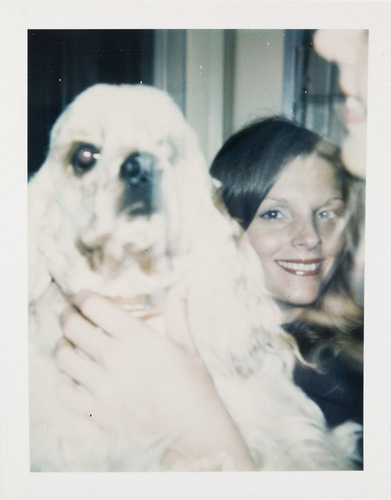
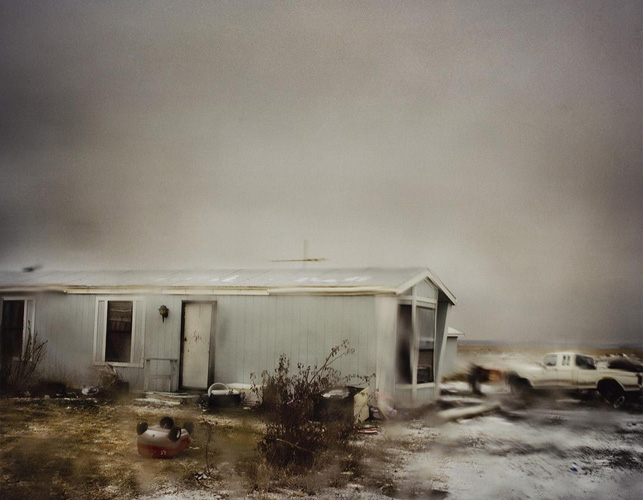
For your first portfolio, you will focus on making images that explore community identity.
We began this session with Soundsuit and Our Town, two artworks that explore how communities and individuals see themselves versus how they are seen by others. You will now spend time looking at the communities that you belong to—both the people and the environment, but mostly the people. You may think of your friends, family, school or neighborhood as your community. Perhaps you are part of small communities such as a soccer team, a step team, or Scouting. Even the bus you ride every day can be a community. Your task is to see the people who are part of your community—friends and strangers—with fresh eyes and to take candid photos that show what it’s like to be part of your community.
You might take photos that chronicle a single day in your life, or you might choose to record one aspect of community that you think is important or you might pick a community location and photograph the people who are there at different times of day.
Don’t worry about taking perfect pictures. The point is to look, notice, and record. You might even be surprised at what you actually see versus what you thought was there!
Here are some prompts to get you started. Pick and choose ideas that inspire you.
- The people in my community are...
- My community’s signature landmark is…
- One thing about my community that I’ve always wondered...
- We will change...
After you are done taking pictures, choose 5-10 to share. Your submission should include the following:
- 5-10 photos collected in one document
- A brief description of each photo and why you included it
- A title for your collected works
Save your file and upload it to Portfolio: Session 1, My Community.
Portfolio Project


For your first portfolio, you will focus on making images that explore community identity.
We began this session with Soundsuit and Our Town, two artworks that explore how communities and individuals see themselves versus how they are seen by others. You will now spend time looking at the communities that you belong to—both the people and the environment, but mostly the people. You may think of your friends, family, school or neighborhood as your community. Perhaps you are part of small communities such as a soccer team, a step team, or Scouting. Even the bus you ride every day can be a community. Your task is to see the people who are part of your community—friends and strangers—with fresh eyes and to take candid photos that show what it’s like to be part of your community.
You might take photos that chronicle a single day in your life, or you might choose to record one aspect of community that you think is important or you might pick a community location and photograph the people who are there at different times of day.
Don’t worry about taking perfect pictures. The point is to look, notice, and record. You might even be surprised at what you actually see versus what you thought was there!
Here are some prompts to get you started. Pick and choose ideas that inspire you.
- The people in my community are...
- My community’s signature landmark is…
- One thing about my community that I’ve always wondered...
- We will change...
After you are done taking pictures, choose 5-10 to share. Your submission should include the following:
- 5-10 photos collected in one document
- A brief description of each photo and why you included it
- A title for your collected works
Save the file and submit it to your teacher.
Overview
In Part 5, you have an opportunity to explore the historical context of this week’s artworks.
Deep Dive
The following resources are intended to help you gain a deeper understanding of the context of this week’s session.
- Learn more about the significance of Rodney King in American history in the article “Rodney King riots 25 years later: a view from the corner where it all began,” from The Guardian.
- In 1917, tens of thousands of Black Americans silently protested against racial violence. Read about it in “100 Years Ago African-Americans Marched Down 5th Avenue to Declare that Black Lives Matter” by Chad Williams, published in The Conversation.
- Martin Luther King’s “Letter from a Birmingham Jail” is considered the most significant document of the civil rights movement.
- The video Aug. 11, 1965—The Watts Riots Begin from Voices of the Civil Rights Movement depicts how the week-long riots were sparked in Watts, California, following a traffic stop involving two Black brothers.
- Timeline: South Central Los Angeles from Independent Lens outlines the dramatic changes experienced by the area known as South Central Los Angeles over the last half-century.
- The UCLA video Art and Engineering Intersect at Watts Towers for UCLA Team shows the work done by art conservators to preserve the Watts Towers. “World Heritage Consideration for Watts Towers of Simon Rodia State Historic Park” on the California State Parks website includes wonderful images of this proposed UNESCO World Heritage Site.
Session Resources
- Orca Bates Assignment
- “Jamie Wyeth's ‘Orca Bates’: Picturing Maine,” by Christopher Crosman, The Free Press
- Introducing Formal Analysis: Still Life, J. Paul Getty Museum
- How to Do Visual (Formal) Analysis in Art History, Smarthistory
- Word Cloud
- Nick Cave Brings Art, Sculpture to Life with Soundsuits, PBS NewsHour
- “About the Art: Soundsuit”
- “Rethinking the Town Hall: Nick Cave on ‘Until,’ His Massive MASS MoCA Installation,” ARTNEWS
- “Kerry James Marshall: Depicting the world as he sees it,” CBS Sunday Morning
- “The art of Kerry James Marshall,” CBS Sunday Morning
- “Unseen photographs of civil rights conflict in Birmingham, Alabama, 1963,” The Guardian
- “Watts riots eerily echo racial tensions 50 years later,” Olivia Kestin and Adam Howard, MSNBC
- “About the Art: Our Town”
- “Kerry James Marshall’s Paintings Show What It Means to Be Black in America,” Holland Cotter, New York Times
- “Towers of Power,” Sara Catania, Los Angeles Times
- “Rodney King riots 25 years later: a view from the corner where it all began,” The Guardian.
- “100 Years Ago African-Americans Marched Down 5th Avenue to Declare that Black Lives Matter,” Chad Williams, The Conversation
- Martin Luther King’s “Letter from a Birmingham Jail”
- Aug. 11, 1965—The Watts Riots Begin, Voices of the Civil Rights Movement
- Timeline: South Central Los Angeles, Independent Lens
- Art and Engineering Intersect at Watts Towers for UCLA Team, UCLA
- “World Heritage Consideration for Watts Towers of Simon Rodia State Historic Park,” California State Parks website

